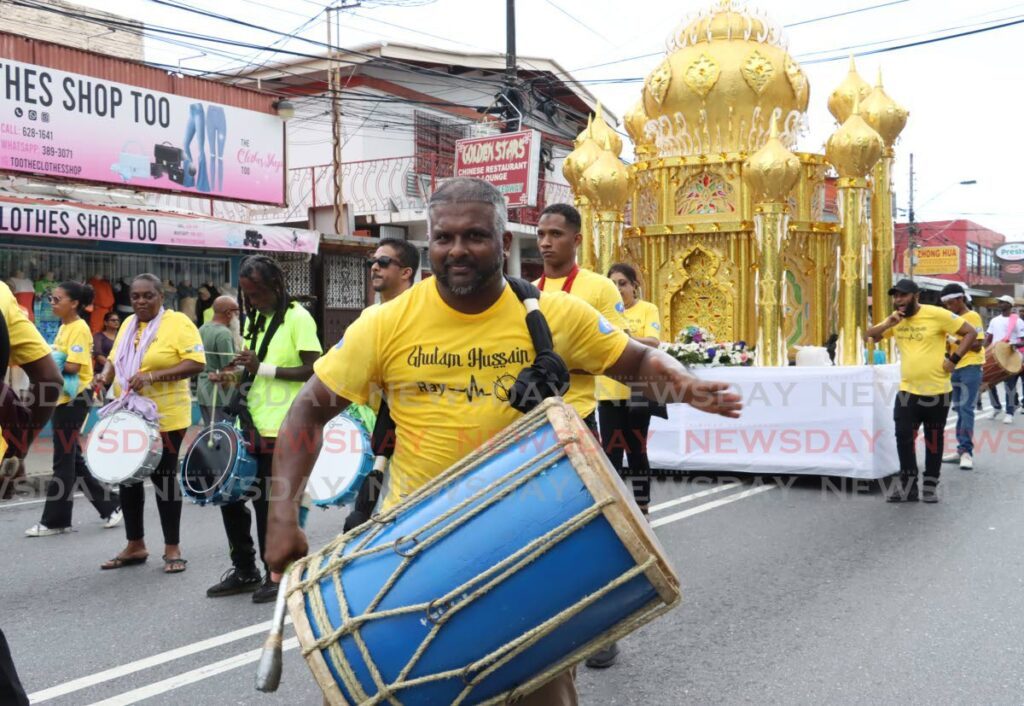Hosay commemoration ends in St James

Rain did not stop Hosay commemorations in St James on Wednesday, as members of the community observed Ashura Day, the final day of the observance.
According to researcher Satnarine Balkaransingh, Hosay is held on the first ten days of Muharram, the first month of the Islamic calendar. It was brought to TT by indentured labourers who came to work on the sugarcane plantations. It commemorates the martyrdom of Hussein (Hussain), the grandson of the Prophet Mohammed, his younger brother Janab Hazrat Abass (Hassan), and 70 other friends and relatives.
In Trinidad, the first six days consist of fasting, prayer, and building the tadjahs. The final four days are Flag Night, Small Hosay, Big Hosay and Ashura when the tadjahs take part in a procession. They are later disposed of in the sea.
Ronald Lakhan of Panchaiti Hosay, leader of one of five tadjahs participating in Wednesday’s procession, said his family had been participating in Hosay ceremonies for the last 180 years.
“The Indians that came here from Uttar Pradesh and Bihar brought their culture here to TT. Bringing it here, they believed if they offered up something if their mother, father or child was sick, they would get healed. They decided to build a tadjah and whatever their problems were, their ancestors would help them with it. They made a promise. Any other promise is a promise Hosay.
“This Hosay is the people’s Hosay. Panchaiti means five people come together in the village to form one of these taziyas or tadjas. Hosay is a colloquial name for Hussain but in TT dialect, the quickest thing to come out of their mouths is Hosay, you don’t hear the N.”
Before the procession, which began around noon, members of the Imam-e-Zamana Mission (IZM), a Muslim organisation based in Port of Spain and Arima, hosted an open-air Hosay commemoration at the Amphitheatre, St James. Member Qain Abdul-Waasi said while the organisation commemorates Hosay every year, it was the second time it hosted an open yard event where it engaged the public.
“We had one last year and it was 100 per cent successful. Last night, during the display of the tadjahs and the tassa, every single Hosay yard stopped here and interacted with us. We gave out free water, leaflets, gifts to encourage people to learn about what happened during the massacre.”
In addition to Panchaiti, four other groups presented tadjahs. These were Cocorite Hosay, Ghulam Hosein Hosay, Bis Ali Hosay and Balma/Balma Youths Hosay. All the tadjahs were accompanied by tassa drummers.
The streets of St James were blocked off for the procession. Some residents and shopkeepers were heard complaining about having to walk to Long Circular Road to get out of the area.
The Hosay procession has been held annually since 1854, having arrived with indentured labourers from India (from 1845-1917) as a Shia Muslim observance. In 1884, the British authorities banned the event, owing to ostensible concerns about public gatherings. On October 30, 1884, what became known as the Hosay Massacre took place when police in San Fernando fired into the crowd following the procession. Once the crowd had dispersed, 22 people were found dead and another 120 injured.

Comments
"Hosay commemoration ends in St James"